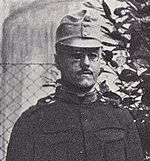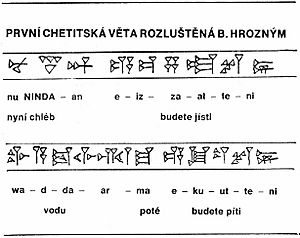Bedřich Hrozný facts for kids
Quick facts for kids
Bedřich Hrozný
|
|
|---|---|

Hrozný in 1915
|
|
| Born | 6 May 1879 Lysá nad Labem, Bohemia, Austria-Hungary
|
| Died | 12 December 1952 (aged 73) |
| Nationality | Czech |
| Known for | Hittitology |
| Scientific career | |
| Fields | Orientalist |
| Signature | |
 |
|
Bedřich Hrozný (born May 6, 1879 – died December 12, 1952) was a brilliant Czech expert in ancient languages and a linguist. He is famous for figuring out the ancient Hittite language. He showed that Hittite was part of the Indo-European language family, which includes languages like English, Spanish, and Hindi. His work was super important for understanding the Hittite civilization.
Contents
Who Was Bedřich Hrozný?
Bedřich Hrozný was born in a town called Lysá nad Labem in Bohemia. This area was part of Austria-Hungary at the time. From a young age, he loved learning languages.
Hrozný's Early Studies
In the town of Kolín, he started learning Hebrew and Arabic. Later, at the University of Vienna, he studied many ancient languages. These included Akkadian, Aramaic, Ethiopian, Sumerian, and Sanskrit. He also learned about cuneiform, which was an ancient writing system. This system was used in places like Asia Minor, Mesopotamia, and Persia. He also studied orientalism at Humboldt University of Berlin.
Hrozný's Amazing Career
In 1905, after working on archaeological digs in Palestine, Hrozný became a professor at the University of Vienna.
Discovering the Hittite Language
A big moment came in 1906. A German team found many ancient clay tablets at Hattusa in modern Turkey. These tablets were written in cuneiform, but the language was a mystery. Even while serving in the Austro-Hungarian army during World War I, Hrozný worked on this puzzle. In 1917, he published his findings. He showed that this unknown language, now called Hittite, belonged to the Indo-European language family. This was a huge breakthrough!
Archaeological Expeditions
In 1925, Hrozný led a Czech team of archaeologists. They found 1000 cuneiform tablets in a Turkish village called Kültepe. These tablets contained old contracts and letters from Assyrian merchants. His team also dug up parts of the nearby ancient Hittite city of Kanesh.
Founding Archiv Orientální
In 1929, Hrozný started a journal called Archiv Orientální. This journal became one of the most important publications for studying ancient Eastern cultures.
Later Work and Challenges
Later in his life, Hrozný tried to figure out other ancient scripts. These included Hittite hieroglyphics and scripts from ancient India and Crete. From 1919 to 1952, he was a professor at Charles University in Prague. He taught about cuneiform and ancient Eastern history. During the German occupation of Czechoslovakia, he became the rector (head) of Charles University from 1939 to 1940. He even helped some students escape arrest during a difficult time in 1939. He bravely told a German officer that they could not arrest students on the university's land. Sadly, a stroke in 1944 stopped his scientific work.
How Hrozný Deciphered Hittite
To solve the mystery of the Hittite language, Bedřich Hrozný focused on two sentences. These sentences appeared in an ancient text and read: nu NINDA-an ezzatteni watar-ma ekutteni.
Cracking the Code
- At that time, experts knew that the symbol NINDA meant "bread" in Sumerian.
- Hrozný thought the ending -an might be a Hittite way to show the direct object of a verb.
- Then, he guessed that the second word, ed-/-ezza, had something to do with bread. He thought it could mean "to eat."
- He compared it to similar words in other languages, like the Latin word edo, the English word eat, and the German word essen.
- This led him to believe that NINDA-an ezzatteni meant "you will eat bread."
Connecting the Dots
- In the second sentence, Hrozný noticed the word watar. This word sounded a lot like the English word water and the German word Wasser.
- The last word, ekutteni, had a root eku-. This seemed similar to the Latin word aqua (which also means water).
- So, he translated the second sentence as "you will drink water."
The Big Realization
Hrozný soon realized that the Hittites were speaking an Indo-European language. This was a huge discovery! It made it much easier to understand and read their cuneiform tablets. Using these amazing insights, Hrozný kept working. He was able to publish a full grammar of the Hittite language in 1917.
See also
 In Spanish: Bedřich Hrozný para niños
In Spanish: Bedřich Hrozný para niños


